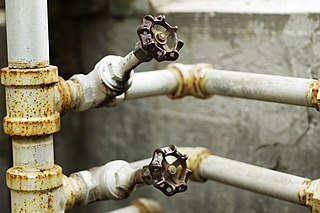 W
WA valve is a device or natural object that regulates, directs or controls the flow of a fluid by opening, closing, or partially obstructing various passageways. Valves are technically fittings, but are usually discussed as a separate category. In an open valve, fluid flows in a direction from higher pressure to lower pressure. The word is derived from the Latin valva, the moving part of a door, in turn from volvere, to turn, roll.
 W
WA valve actuator is the mechanism for opening and closing a valve. Manually operated valves require someone in attendance to adjust them using a direct or geared mechanism attached to the valve stem. Power-operated actuators, using gas pressure, hydraulic pressure or electricity, allow a valve to be adjusted remotely, or allow rapid operation of large valves. Power-operated valve actuators may be the final elements of an automatic control loop which automatically regulates some flow, level or other process. Actuators may be only to open and close the valve, or may allow intermediate positioning; some valve actuators include switches or other ways to remotely indicate the position of the valve.
 W
WAn adjustable pressure-limiting valve is a type of flow control valve used in anaesthesiology as part of a breathing system. It allows excess fresh gas flow and exhaled gases to leave the system while preventing ambient air from entering.
 W
WAn air-operated valve is a type of power operated valve that uses air pressure against a piston or diaphragm to produce linear or circular movement to operate a valve. Types are 2-way, 3-way and 4-way. The 2 way air-operated valves can be either normally closed or normally opened.
 W
WAn angle seat piston valve is a pneumatically-controlled valve with a piston actuator providing linear actuation to lift a seal off its seat. The seat is set at an angle to provide the maximum possible flow when unseated. Angle seat piston valves are particularly suited to applications where high temperatures and large flow rates are required, such as steam or water. When used in reverse some models of angle seat piston valve will eliminate water hammer when operated.
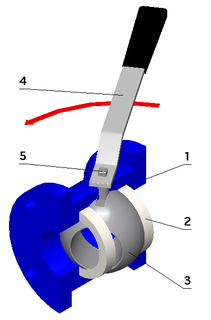 W
WA ball valve is a form of quarter-turn valve which uses a hollow, perforated and pivoting ball to control flow through it. It is open when the ball's hole is in line with the flow and closed when it is pivoted 90-degrees by the valve handle. The handle lies flat in alignment with the flow when open, and is perpendicular to it when closed, making for easy visual confirmation of the valve's status. The shut position 1/4 turn could be in either CW or CCW direction.
 W
WA beer tap is a valve, specifically a tap, for controlling the release of beer. While other kinds of tap may be called faucet, valve or spigot, the use of tap for beer is almost universal. This may be because the word was originally coined for the wooden valve in traditional barrels. Beer served from a tap is largely known as draught beer, though beer served from a cask is more commonly called cask ale, while beer from a keg may specifically be called keg beer. Beer taps can be also used to serve similar drinks like cider or long drinks.
 W
WA blast valve is used to protect a shelter, such as a fallout shelter or bunker, from the effects of sudden outside air pressure changes. A nuclear weapon creates a shock wave, which may produce sudden pressure changes of more than an atmosphere even several kilometers or miles from the detonation point. After the shock wave passes, a sudden negative pressure follows.
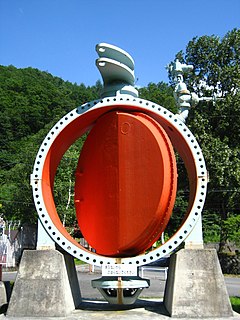 W
WA butterfly valve is a valve that isolates or regulates the flow of a fluid. The closing mechanism is a disk that rotates.
 W
WA check valve, clack valve, non-return valve, reflux valve, retention valve or one-way valve is a valve that normally allows fluid to flow through it in only one direction.
 W
WDiaphragm valves consists of a valve body with two or more ports, an elastomeric diaphragm, and a "weir or saddle" or seat upon which the diaphragm closes the valve. The valve body may be constructed from plastic, metal, wood or other materials depending on the intended use.
 W
WThe double-beat valve, drop valve or equilibrium valve is a type of poppet valve arranged to allow it to be opened against a high pressure with a minimum of force. One of its uses is in steam engines to admit steam to the cylinders and to release the exhaust. In stationary steam engines it is usually operated by trip valve gear while in railway locomotives a valve gear such as Caprotti is used.
 W
WA duckbill valve is a check valve, usually manufactured from rubber or synthetic elastomer, and has 2 flaps, usually shaped like the beak of a duck. It is commonly used in medical applications to prevent contamination due to backflow.
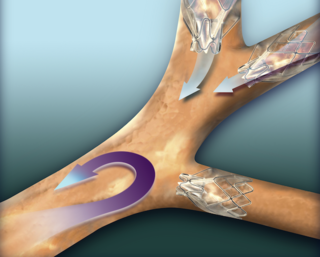 W
WAn endobronchial valve (EBV), is an implantable medical device – a small, one-way valve, which is implanted in an airway in the pulmonary system to treat one of several lung conditions. Endobronchial valves are typically implanted using a flexible delivery catheter advanced through a bronchoscope, and thus they are minimally invasive. The valves are also removable if they are not working properly.
 W
WA faucet aerator is often found at the tip of modern indoor water faucets. Aerators can simply be screwed onto the faucet head, creating a non-splashing stream and often delivering a mixture of water and air.
 W
WThe four-way valve or four-way cock is a fluid control valve whose body has four ports equally spaced round the valve chamber and the plug has two passages to connect adjacent ports. The plug may be cylindrical or tapered, or a ball.
 W
WA globe valve, different from ball valve, is a type of valve used for regulating flow in a pipeline, consisting of a movable plug or disc element and a stationary ring seat in a generally spherical body.
 W
WA hydrogen valve is a special type of valve that is used for hydrogen at very low temperatures or high pressures in hydrogen storage or for example hydrogen vehicles.
 W
WA Larner–Johnson valve is a mechanism used in dams and water pumping to control the flow of water through large pipes. The valve is suited to handling high velocity flow with minimal turbulence, even when partially open, and the actuating force can be provided by the water flow it is controlling. It was manufactured in the early 20th century by the Larner-Johnson Company in the US. The valves are still manufactured in the United Kingdom by Blackhall Engineering Ltd. These valves have been constructed in sizes up to 21 feet (6.4 m) diameter and controlling a hydraulic head of 1,000 feet (300 m).
 W
WMulti-seat valves, or multi-port valves, are used to shut off or control complex liquid flows in sterile areas in the beverage and food industry as well as in the fine chemical and pharmaceutical industry. Multi-seat valves often replace combinations of several single-seated valves in aseptic processing.
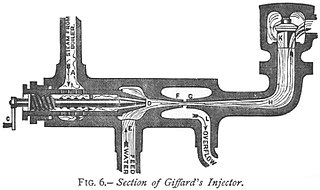 W
WA needle valve is a type of valve with a small port and a threaded, needle-shaped plunger. It allows precise regulation of flow, although it is generally only capable of relatively low flow rates.
 W
WA piston valve is a device used to control the motion of a fluid along a tube or pipe by means of the linear motion of a piston within a chamber or cylinder.
 W
WPlug valves are valves with cylindrical or conically tapered "plugs" which can be rotated inside the valve body to control flow through the valve. The plugs in plug valves have one or more hollow passageways going sideways through the plug, so that fluid can flow through the plug when the valve is open. Plug valves are simple and often economical.
 W
WA proportioning valve is a valve that relies on the statics to supply a reduced pressure to an output line.
 W
WReed valves are a type of check valve which restrict the flow of fluids to a single direction, opening and closing under changing pressure on each face. Modern versions often consist of flexible metal or composite materials.
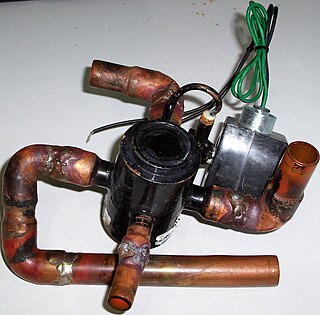 W
WA reversing valve a type of valve and is a component in a heat pump, that changes the direction of refrigerant flow. By reversing the flow of refrigerant, the heat pump refrigeration cycle is changed from cooling to heating or vice versa. This allows a residence or facility to be heated and cooled by a single piece of equipment, by the same means, and with the same hardware.
 W
WA rotary valve is a type of valve in which the rotation of a passage or passages in a transverse plug regulates the flow of liquid or gas through the attached pipes. The common stopcock is the simplest form of rotary valve. Rotary valves have been applied in numerous applications, including:Changing the pitch of brass instruments. Controlling the steam and exhaust ports of steam engines, most notably in the Corliss steam engine. Periodically reversing the flow of air and fuel across the open hearth furnace. Loading sample on chromatography columns. Certain types of two-stroke and four-stroke engines. Most hydraulic automotive power steering control valves.
 W
WA saddle valve is a valve used to supply liquid where a low volume, low pressure stream is required. The name is derived from the fact that it is mounted in such a way that it "saddles" the line, mounting it from both sides.
 W
WA safety valve is a valve that acts as a fail-safe. An example of safety valve is a pressure relief valve (PRV), which automatically releases a substance from a boiler, pressure vessel, or other system, when the pressure or temperature exceeds preset limits. Pilot-operated relief valves are a specialized type of pressure safety valve. A leak tight, lower cost, single emergency use option would be a rupture disk.
 W
WA shuttle valve is a type of valve which allows fluid to flow through it from one of two sources. Generally a shuttle valve is used in pneumatic systems, although sometimes it will be found in hydraulic systems.
 W
WA solenoid valve is an electromechanically-operated valve.
 W
WA sun valve is a flow control valve that automatically shuts off gas flow during daylight. It earned its inventor Gustaf Dalén the 1912 Nobel Prize in Physics. Subsequently other variants of sun valve were developed for various different uses.
 W
WA tap is a valve controlling the release of a liquid or gas.
 W
WA thermal expansion valve or thermostatic expansion valve is a component in refrigeration and air conditioning systems that controls the amount of refrigerant released into the evaporator and is intended to regulate the superheat of the vapor leaving the evaporator. Although often described as a "thermostatic" valve, an expansion valve does not regulate temperature, the temperature of the evaporator will vary with the evaporation pressure.
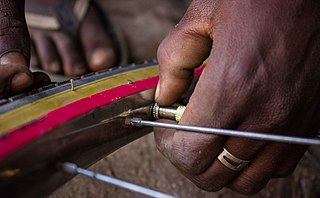 W
WA valve stem is a self-contained valve which opens to admit gas to a chamber, and is then automatically closed and kept sealed by the pressure in the chamber, or a spring, or both, to prevent the gas from escaping. They are most commonly used on automobile, motorcycle, and bicycle tires, but also for many other applications.